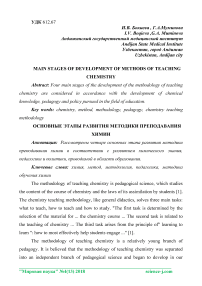Main stages of development of methods of teaching chemistry
Автор: Boqieva I.V., Muminova G.A.
Журнал: Мировая наука @science-j
Рубрика: Основной раздел
Статья в выпуске: 4 (13), 2018 года.
Бесплатный доступ
Four main stages of the development of the methodology of teaching chemistry are considered in accordance with the development of chemical knowledge, pedagogy and policy pursued in the field of education.
Chemistry, method, methodology, pedagogy, chemistry teaching methodology
Короткий адрес: https://sciup.org/140263496
IDR: 140263496
Текст научной статьи Main stages of development of methods of teaching chemistry
The methodology of teaching chemistry is pedagogical science, which studies the content of the course of chemistry and the laws of its assimilation by students [1]. The chemistry teaching methodology, like general didactics, solves three main tasks: what to teach, how to teach and how to study. "The first task is determined by the selection of the material for ... the chemistry course ... The second task is related to the teaching of chemistry ... The third task arises from the principle of" learning to learn ": how to most effectively help students engage ..." [1].
The methodology of teaching chemistry is a relatively young branch of pedagogy. It is believed that the methodology of teaching chemistry was separated into an independent branch of pedagogical science and began to develop in our country after the Great October Revolution, when chemistry was included as a curriculum in the curriculum of the secondary general school. The core of the chemistry teaching methodology is the content of chemical education.
The change in the content of chemical education during the whole period of the existence of a systematic course of chemistry was influenced and influenced by three main factors: the level of development of chemical knowledge, the policy pursued in the field of education, the achievements of pedagogical science. We distinguish four stages of the development of the content of chemical education, and, consequently, the very methodology of teaching chemistry, depending on the influence of this or that factor. The first stage in the development of the methodology is due, first of all, to the achievements of the chemical science.
VI Kuznetsov notes that before chemistry there were always two problems: practical - obtaining substances with the necessary properties and theoretical - the problem of the genesis of the properties of substances. In the process of development of chemical knowledge, VI Kuznetsov identifies the formation of four conceptual systems of chemistry (Figure 1). As can be seen from the figure, by the end of the 19th century, three conceptual systems of chemistry were practically formed, which had a significant impact on the teaching methodology. The beginning of the first stage of the development of the methodology of teaching chemistry - the formation of approaches to the teaching of chemistry, in our opinion, can be dated to the mid-18th century and is associated with the name of M.V. Lomonosov.
At that time, chemistry was oriented toward practical application. M.V. Lomonosov wrote in: "The study of chemistry has a dual purpose: one is the improvement of the natural sciences, the other is the multiplication of life's goods. The last 180 goal ... especially in the present and the previous centuries, has achieved good success, the first ... almost did not enrich the philosophical knowledge of nature. "
In the teaching of chemistry, M.V. Lomonosov relied on the achievements of all natural scientific knowledge, it was M.V. Lomonosov that laid the foundations for a demonstration chemical experiment, which the professor widely used in lectures.
M.V. Lomonosov pointed out that the basis of teaching chemistry should be based on atomistic theory. The beginning of the 19th century is accompanied by a certain stagnation in the development of chemistry in comparison with the times of M.V.Lomonosov, which is objectively connected with the contingent of trainees and with those tasks that the tsarist government set before classical universities. By the thirties of the nineteenth century, Russia lacked a chemistry textbook that would reflect the latest achievements of science and expound the facts and theories of chemistry in a form accessible to a wide range of readers. In the year 1831. G.I. Hess publishes the textbook "Foundations of Pure Chemistry", which was reprinted seven times and was adopted in Russian educational institutions as the main guide to chemistry. G.I. Hess's textbook was accompanied by explanatory experiments in chemistry and was based on experiments. G.I. Hess introduced practical exercises and the demonstration experiment was improved . At the beginning of the book, an atomistic theory is given, which avoids a number of unnecessary repetitions, theories are considered in connection with the experimental material. A special merit of G.I. Hess is the introduction of Russian nomenclature and wide application in the textbook of the equations of chemical reactions.
Список литературы Main stages of development of methods of teaching chemistry
- Браун Т., Лемей Т.Ю. Химия - в центре наук. - Т. 1,2. - М.: Мир. 1983
- Горелов А.А. Концепции современного естествознания. - М.: Центр, 2002.
- Карпенков С.Х. Концепции современного естествознания. Учебник. - М.: ЮНИТИ, 1997.


